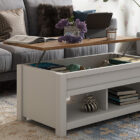Craft dream interiors with versatile and cost-effective MDF material.
Visualise this: As you renovate your ideal house, you see the flawless interior design with gleaming surfaces, tasteful furnishings, and sleek cabinetry accentuating every nook and corner. One material that sticks out among the many options is MDF.
Materials play a crucial role in the field of interior design since they determine not only appearance but also longevity and usability. Presenting Medium Density Fiberboard, or MDF material that’s sometimes overlooked and underestimated but can turn your living area into a work of art. In this context, let us look into how it amplifies your home interiors. But first, it’s crucial to understand what MDF material is and its constituents.
What is MDF Material Made of?
Made from wood fibres, glue, and wax, MDF is an engineered wood product that is crushed at high temperatures and pressures. The result? A knot-free board that is smooth, dense, and multipurpose, appropriate for a wide range of interior uses. Because of the MDF material composition, which enables accurate shape and cutting, it is favoured by both designers and carpenters.
Misconceptions regarding MDF persist despite its exceptional capabilities, frequently casting doubt on its suitability for interior design.

Busting Some Myths Surrounding MDF Board Material
Let’s eliminate a few myths surrounding this material before we dig further. Despite what many people think, it is not the same as plywood or particleboard. Although they share some similarities, MDF has a smoother surface and is more stable due to its homogenous and denser structure.
When it comes to worries about toxicity or health risks, MDF presents no health risks when made and utilised appropriately. After all, what is MDF construction material? If we look closely, it’s just wood fibres, glue, and wax. When treated under the right temperature and pressure, it can be a viable option for your interiors. Having debunked these myths, it has pros and cons, both of which should be carefully considered while reinventing your space.

Advantages of Using MDF Material
- MDF wardrobe material or for kitchen cabinets are widely seen and used in different housing decors and interiors. It has certain advantages that make it a suitable option:
- Value for Money: Compared to solid wood or other engineered materials, the MDF material cost is cheaper and more affordable, making it suitable for various interior design projects.
- Myriad Design and Finishes: The homogeneous composition and smooth surface enable a wide variety of finishes, including paints and veneers. Due to its versatile nature, it’s also an ideal choice for furniture. Furniture constructed from this material can be in various styles, from traditional to modern.
- Clean Surface for Painting and Finishing: MDF offers a constant, smooth surface ideal for obtaining flawless paint finishes or detailed designs, in contrast to other natural timbers that may have knots and unclear or uneven textures.

Drawbacks to Consider While Using MDF Board Material
- MDF material for kitchen cabinets or wardrobes is a popular choice. But, as we touched on already, it has some drawbacks, which are as follows:
- Susceptibility to Moisture: One of the main issues is the MDF board material’s susceptibility to moisture. MDF’s appropriateness for moist or spill-prone regions is limited since it can swell, bend, or even disintegrate when exposed to high humidity levels or direct water contact.
- Environmental Aspects: Using wood fibres from different sources during the MDF production may affect forest cover and biodiversity. Furthermore, certain types of MDF could include formaldehyde-based resins, which, if improperly handled, could pose health and environmental risks.

Some Tips to Keep in Mind While Using MDF Material for Home Interiors
- Precise Measurements and Careful Handling: Take correct measurements and exercise caution when handling MDF. Cut and shape the material with high-quality, sharp tools to reduce splintering and ensure smooth edges.
- Sealing to Prevent Moisture: MDF board material is sensitive to moisture, an important factor to consider. First, use the proper primers, sealants, or paints to seal the surfaces and edges. This procedure establishes a barrier against moisture and improves MDF’s resilience to swelling or warping in humid areas.
- Preventing Edge Swelling: When exposed to moisture, MDF material edges are especially vulnerable to swelling. To strengthen these weak spots, apply edge banding or sealants made especially for MDF. Over time, adequately sealed edges preserve the material’s integrity and improve durability.
- Enough Airflow During Installation: If MDF dust is breathed in during cutting, sanding, or shaping, it might be harmful to one’s health. Make sure your workspace has enough ventilation. Consider utilising dust extraction equipment or donning the proper masks or respirators to reduce exposure and encourage a safer working environment.

In conclusion, choosing MDF material for home interiors demands a balanced approach. While it excels in crafting furniture, cabinets, and decorative elements, caution is warranted in moisture-prone spaces like kitchens or bathrooms. Understanding its limitations helps make informed decisions and ensure optimal use in specific applications. With its blend of affordability and versatility, MDF offers a canvas for creativity in home interiors. For more information, MDF material cost and a variety of home interior styles, get in touch with our specialist designers today right here: Contact Us
Also, Check Out
- Unlock the Versatility of MDF Board Designs
- Why MDF Board Design is Best for Kitchen Cabinets
- 7 Reasons to Invest in Pre-Laminated MDF Board
FAQs on MDF Material
1. Are there different grades of MDF, and how do they affect its use in home interiors?
Yes, MDF comes in various grades based on density and properties. Higher-density grades offer increased strength and durability and are suitable for heavy-duty applications like cabinets or furniture. In contrast, lower-density grades are more cost-effective for lighter applications like moulding or trim work.
2. Can MDF be customised with various finishes, paints, and designs for interior applications?
Of course! MDF’s smooth surface allows for diverse finishes—from paints and veneers to laminates or intricate designs. Its adaptability makes it a preferred choice for customised interior elements, offering flexibility in achieving desired aesthetics.
3. Is MDF considered an environmentally friendly or sustainable material for home interiors?
The sustainability of MDF depends on the manufacturing process and sourcing of raw materials. While it uses recycled wood fibres and reduces waste, concerns exist regarding using formaldehyde-based resins. Opting for low-formaldehyde or eco-certified MDF can improve its environmental credentials.
4. Are there specific design styles or room types where MDF is particularly well-suited?
MDF’s versatility makes it suitable for various design styles and room types. It’s commonly used in modern and contemporary designs for cabinets, shelving, and furniture. However, due to its susceptibility to water damage, it might be less ideal for high-moisture areas like bathrooms or kitchens.
5. How do I care for and clean MDF furnishings and elements to maintain their appearance?
Cleaning MDF involves gentle care to maintain its appearance. Use a mild, non-abrasive cleaner and a soft cloth to wipe surfaces. Avoid excessive water exposure or harsh chemicals, as they can damage the finish. Regular dusting and prompt cleanup of spills help preserve MDF furnishings.
 Select Category
Select Category













